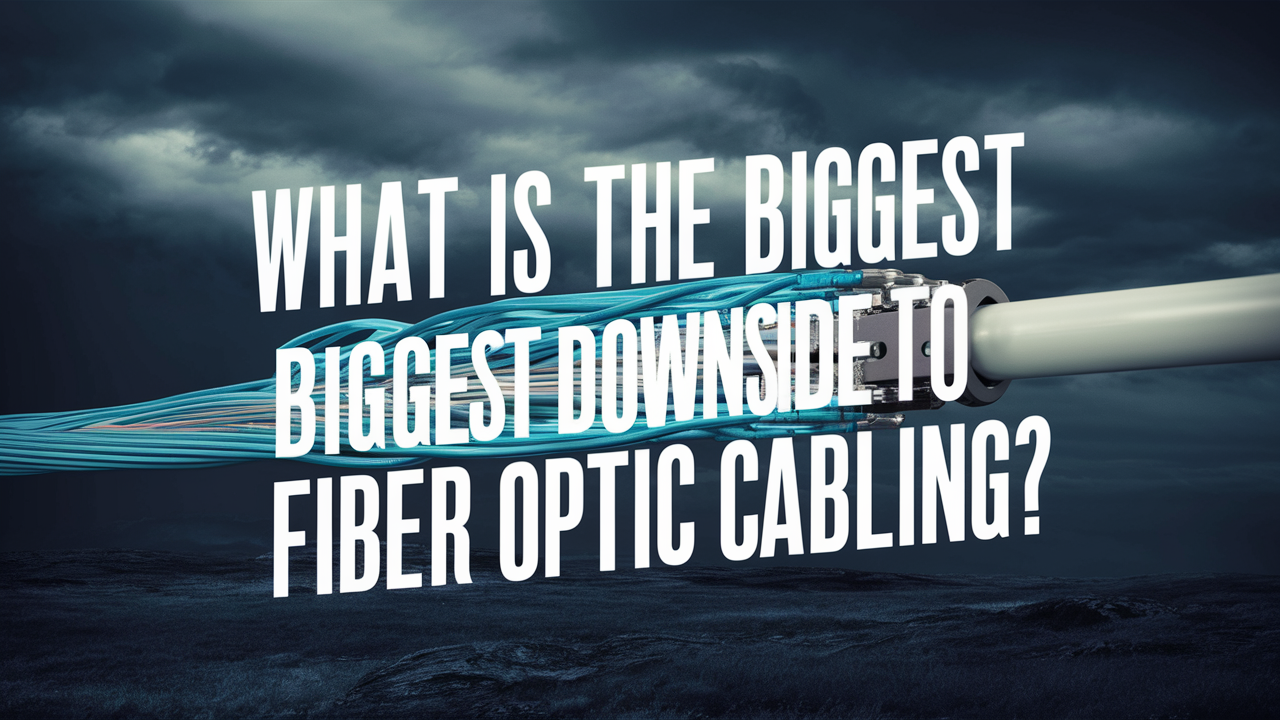What is the biggest downside to fiber optic cabling?

What is the biggest downside to fiber optic cabling
The most significant disadvantage of fiber optic cabling is the relatively high costs that are initially incurred. Fiber optic cables themselves have a cost of about $160 to $250 per 1000ft for the indoor tight-buffered cable, while costs are above $2000 per 1000ft for the armored outdoor cable. Hence, it is 10 to 15 times pricier than conventional copper wire, like the Cat5e or Cat6. The fact that fiber optics is a younger technology than copper adds another factor contributing to the cost of fiber optic transceivers, media converters, patch cables, enclosures, and other such related parts:
This is because fiber optic cable requires more specialist labor and equipment than copper cables. Fiber is easy to break due to bending or tension, due to the delicate nature of the constituent glass fibers. Fiber handling and termination also need additional training and, more importantly, require tools such as cleavers, fiber strippers, and fiber splice trays, among others, to make clean, accurate, and solid splices. Reparations are expensive; for instance, a poor joint or a bad cable portion means that the whole cable installation will need to be pulled out and redone. The equipment required is also expensive, while the fusion splicer, optical loss test set, and OTDR are expensive tools that may range from a few hundred to thousands of dollars.
Though fiber does come with a higher cost in terms of infrastructure at the initial stages, it certainly has a higher bandwidth density and a longer reach compared to the other cables. On the other hand, using a DWDM wavelength, a single fiber strand can transport more than 100 terabits/second of total bandwidth over long distances. Twisted pair copper cabling, on the other hand, offers only a fraction of that capability and is limited to 100 meters if it is to deliver gigabit performance. The bandwidth of Fiber is virtually unending compared to copper. Current transceivers can accommodate numerous terabits per second through one fiber.
As for now, in data centers, fiber optic cabling does come with a higher cost in terms of the material required as well as installation costs when compared to copper-structured cabling. However, many data centers are not willing to pay the extra amount since fiber helps them escalate to other speeds, such as 40G, 100G, etc. It is worth noting that these high speeds cannot be supported by copper-aggregated links. Fiber also has a more compact design and requires significantly fewer links, as thousands of fibers can fit inside a cable the thickness of a pen.
Whereas the fiber cable as a physical medium is virtually indestructible and therefore has an effectively infinite lifetime, other components make up fiber optic networking that do have finite lifetimes. Optical transceivers that transmit and receive data in the form of light pulses from an electrical signal, on average, can work for approximately 10 years if they are used continuously and are placed in perfect environments. The transceivers employing Fabry-Perot lasers that were used in some prior systems may only have a lifespan of 5 years or even less. Anyone investing in fiber networks through venture capitalists or others should also factor in replacement costs while arriving at their ROIs.
Fiber cable in an outside plant environment is vulnerable to damage if installation procedures are not strictly adhered to, or later the cable is interfered with. A fiber strand is incredibly thin, thinner than hair, and if one tries to bend it beyond the minimum bend radius, it will snap. Rodents love to gnaw on cables, and insects can chew through the jackets of exposed cables. It is also important to note that fiber by itself provides no immunity against lightning, power crosses, or other external electrical interference. The armored protection on the surface of the fiber cables makes the fiber cables even more costly than indoor fiber. Fiber optic cable plants that are buried need to be marked on DIGSAFE or other underground utility locators in case there is an intention to dig nearby in the future.
Fiber optic network equipment is power-hungry and requires electrical power to provide power for its operations. Lasers or LEDs, that are sending the light into the fiber, and photodetectors, which receive the light pulses, require electricity. Power is needed even for fiber connections and optical switches, which are used in routing connections around the network. Fiber optic gear tends to include backup batteries, but extended power losses will nonetheless cause live network traffic to drop. Even in a short power interruption, copper passive cabling itself will at least remain electrically functional, so it is at least safe in this regard.
Upgrade to faster, more reliable AT&T Fiber Internet today! Call us at +1 844-905-5002 and get connected with speeds that keep you ahead.
Although light transmission within the fiber optic cable is highly protected against electrical tapping, fiber optic network components such as transceivers are relatively less mechanically secured in comparison to conventional passive copper conductors. In other cases, the glass fiber transmitting sensitive data can be easily connected to be unplugged from powered equipment ports and connected directly to other morphing cyberspy or monitoring apparatus. Copper cabling can also be tapped, albeit with much more effort, or by accessing locker rooms.





